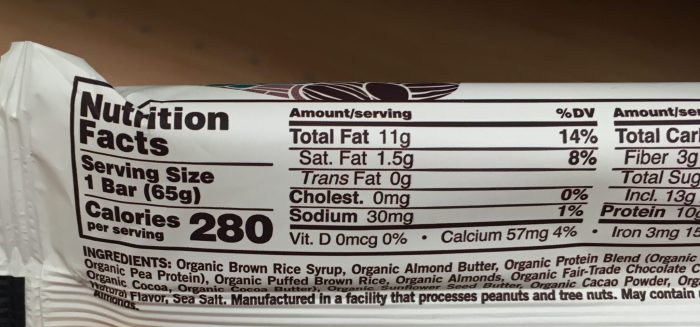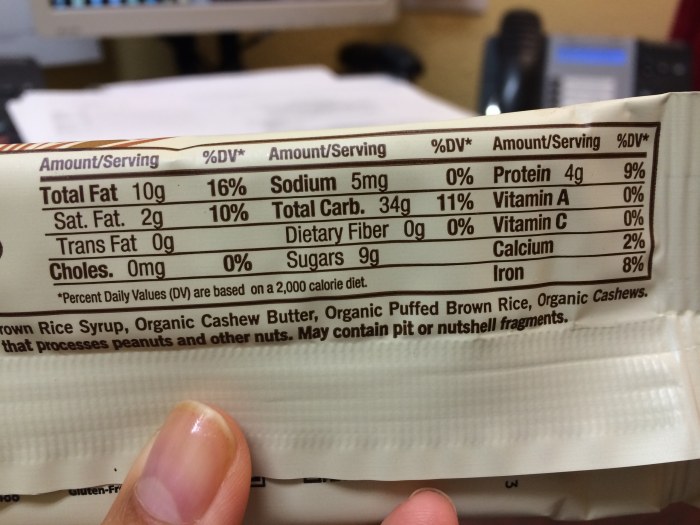Ingredient Examination

Macro bars nutrition facts – Understanding the ingredients in macro bars is crucial for assessing their nutritional value and potential health impacts. Many bars boast high protein and fiber content, but a closer look at the full ingredient list reveals a more complex picture. The quality and quantity of each ingredient significantly affect the overall nutritional profile and the bar’s potential benefits or drawbacks.
Common Macro Bar Ingredients and Their Nutritional Impact
Macro bars typically contain a blend of ingredients designed to provide a balance of macronutrients (protein, carbohydrates, and fats). Common ingredients include protein sources (whey, casein, soy, brown rice protein), carbohydrates (oats, nuts, seeds, dried fruit), fats (nuts, seeds, nut butters), and various sweeteners and additives. The specific impact on nutritional value depends heavily on the proportion and quality of these ingredients.
For instance, a bar heavily reliant on processed carbohydrates and added sugars will offer less nutritional benefit than one primarily composed of whole grains, nuts, and seeds.
Potentially Harmful and Beneficial Ingredients
Several ingredients commonly found in macro bars warrant closer examination. Beneficial ingredients often include whole grains like oats, which provide fiber and sustained energy release. Nuts and seeds contribute healthy fats, fiber, and vitamins. High-quality protein sources, such as whey protein isolate, support muscle growth and repair. Conversely, potentially harmful ingredients include excessive added sugars, artificial sweeteners, and unhealthy trans fats.
Understanding macro bars nutrition facts is crucial for fitness goals, but sometimes a change is needed. For a lean protein boost, consider exploring alternative sources like the healthy fats and omega-3s found in keta salmon nutrition facts , which can help you better understand how to balance your macros. Then, you can use that knowledge to make informed choices about your macro bar consumption and overall diet.
Highly processed ingredients and excessive amounts of saturated fats can also negatively impact health. Artificial sweeteners, while reducing sugar content, have been linked to potential long-term health concerns by some studies. Preservatives, while extending shelf life, might not be beneficial for overall health.
Categorization of Macro Bar Ingredients by Health Impact
The following list categorizes common macro bar ingredients based on their general health impact. It’s important to note that the impact can vary based on the specific ingredient source and processing methods.
- Positive: Oats, almonds, chia seeds, whey protein isolate, Greek yogurt, unsweetened cocoa powder.
- Neutral: Dates (in moderation), coconut flakes (in moderation), peanut butter (depending on added ingredients), brown rice protein.
- Negative: High-fructose corn syrup, artificial sweeteners (sucralose, aspartame), partially hydrogenated oils, excessive added sugars, certain preservatives.
The Role of Artificial Sweeteners, Preservatives, and Flavor Enhancers
Artificial sweeteners, preservatives, and flavor enhancers are often added to macro bars to improve taste, extend shelf life, and reduce costs. However, these ingredients can raise concerns regarding their long-term health effects. Artificial sweeteners, while reducing caloric intake from sugar, might have unintended consequences. Preservatives, while essential for maintaining product quality, may not contribute to nutritional value.
Flavor enhancers often mask the taste of less desirable ingredients. Consumers should be mindful of these additions and opt for bars with minimal processing and natural ingredients whenever possible.
Macro Bar Consumption & Health Implications

Macro bars, convenient sources of macronutrients, can play a role in various dietary contexts. However, understanding their appropriate use and potential effects on health is crucial for safe and effective integration into a balanced lifestyle. This section explores the optimal timing of consumption, potential impacts on health indicators, effective integration strategies, and associated risks of overuse.
Appropriate Contexts for Macro Bar Consumption, Macro bars nutrition facts
Macro bars can be strategically incorporated into a diet to meet specific nutritional needs. Pre-workout, they can provide sustained energy, preventing fatigue during exercise. Post-workout, they aid muscle recovery by replenishing glycogen stores and providing essential amino acids. As a meal replacement, they offer a quick and convenient option, provided they meet the nutritional requirements of a balanced meal.
The choice depends on individual needs and activity levels. For instance, a pre-workout bar might emphasize carbohydrates for immediate energy, while a post-workout bar might include more protein for muscle repair. A meal replacement bar should ideally provide a balance of macronutrients and essential vitamins and minerals.
Effects of Macro Bar Consumption on Health Indicators
The impact of macro bars on health varies greatly depending on the bar’s composition and the individual’s overall diet and activity level. Weight management can be influenced positively if the bar replaces higher-calorie snacks or meals and contributes to a calorie deficit. Energy levels can be boosted by bars with a good balance of carbohydrates and healthy fats, providing sustained release of energy.
However, bars high in sugar can lead to energy crashes. Blood sugar levels can be affected by the glycemic index (GI) of the bar; high-GI bars can cause spikes in blood sugar, while low-GI bars provide a more gradual release of glucose. For example, a bar with complex carbohydrates like oats will have a lower GI than one with refined sugars.
Integrating Macro Bars into a Balanced Diet
To effectively integrate macro bars, consider replacing less nutritious snacks or meals. For example, swapping a sugary candy bar for a protein bar can reduce sugar intake and increase protein consumption. Macro bars can also be incorporated as part of a pre- or post-workout routine, providing convenient nutrition before or after exercise. It’s essential to choose bars with a balanced macronutrient profile and added vitamins and minerals to ensure nutritional completeness.
For example, a balanced bar might contain a combination of protein, complex carbohydrates, and healthy fats, along with added vitamins and minerals.
Risks Associated with Excessive Macro Bar Consumption
Overconsumption of macro bars can lead to several health problems. Excessive intake of added sugars can contribute to weight gain, insulin resistance, and type 2 diabetes. High protein intake from bars might strain the kidneys, especially for individuals with pre-existing kidney conditions. Overreliance on macro bars as a primary food source can lead to nutritional deficiencies if the bars don’t provide a complete range of essential vitamins and minerals.
For instance, an individual consuming multiple bars daily might experience deficiencies in fiber, certain vitamins, and essential fatty acids if the bars do not contain these nutrients. Therefore, moderation and careful selection are crucial to avoid potential health issues.
Quick FAQs: Macro Bars Nutrition Facts
What are the best macro bars for weight loss?
Bars lower in added sugars and higher in protein and fiber are generally better for weight management. Look for bars with at least 10g of protein and less than 5g of added sugar.
Are macro bars suitable for diabetics?
Diabetics should carefully check the carbohydrate and sugar content. Opt for bars with lower glycemic index and consult a doctor or registered dietitian for personalized advice.
Can I rely solely on macro bars for my nutrition?
No. Macro bars should supplement, not replace, a balanced diet. They lack the micronutrient diversity of whole foods.
How can I identify misleading marketing claims on macro bar packaging?
Look for vague or unsupported health claims. Compare the marketing claims to the actual nutritional information on the label. Be wary of overly enthusiastic descriptions that lack scientific backing.

